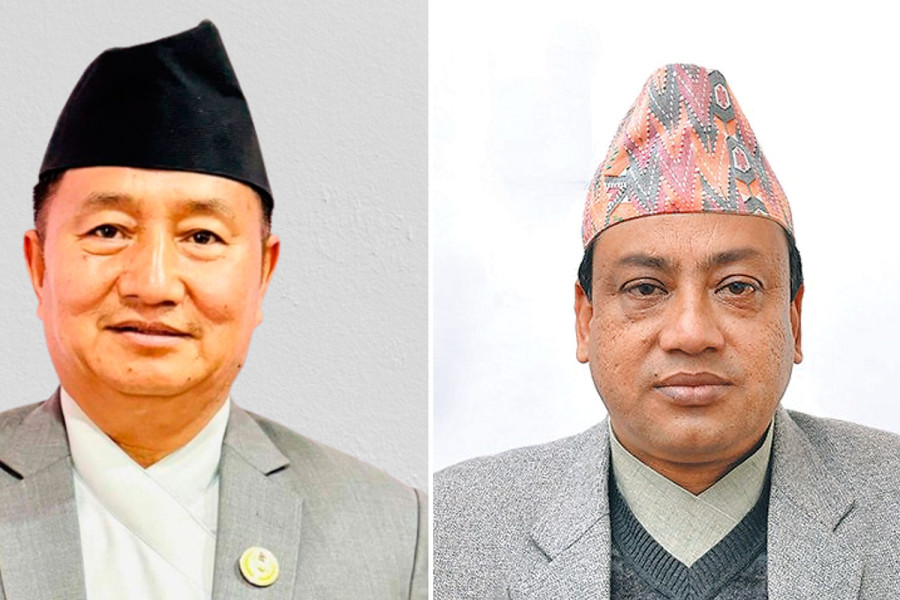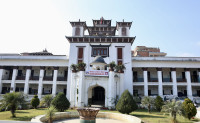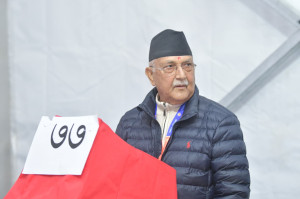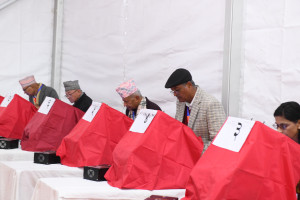Politics
Could Bagmati assembly turmoil be a sign of new instability in provinces?
21 Congress lawmakers move to oust their own chief minister, Bahadur Singh Lama.
Purushottam Poudel
The formation of the coalition government of the Nepali Congress and the CPN-UML at the centre in July last year, had at least one immediate effect—it halted the frequent making and breaking of governments in various provinces.
It gave a sense of stability even in the provinces that are otherwise witness to constant inter- and intra-party wrangling.
However, in Bagmati Province, that year-long stability has now begun to falter.
The situation started to unravel after a group of Congress lawmakers registered a vote of no confidence against Chief Minister Bahadur Singh Lama, who is from the same party.
Some Congress leaders, however, argue that the potential change of provincial government in Bagmati should not be interpreted as a sign of political instability.
Kedar Karki, a Congress leader and former chief minister of Koshi province, claimed that a change of chief minister in Bagmati Province would not destabilise the country’s politics.
“The demand for a change has come from within the party which is leading the government, so it won’t lead to any kind of political instability,” Karki argued.
The no-confidence motion against Bagmati Chief Minister Lama was filed on July 25. The motion, filed by 21 lawmakers from his party, the Congress, seeks his removal as provincial assembly party leader. The Congress has 37 seats in the 110-strong provincial assembly, making it the largest party.
The 21 lawmakers have stood in favour of electing Indra Bahadur Baniya, the Congress provincial president, as new provincial assembly leader.
They registered the no-confidence motion at the provincial assembly party’s secretariat as they have to elect an assembly party leader to replace the chief minister. The Congress party’s constitution states that only the leader of the provincial assembly party can lead the government at provincial and federal levels.
A no-confidence motion can be registered against the provincial assembly party leader if it is supported by at least 25 percent of party lawmakers. In this case, more than 50 percent have stood against the current chief minister and assembly party leader Lama.
Congress lawmakers and ministers have accused Lama of acting arbitrarily in budget-making and “selling off” development projects.
Provincial Minister for Cooperative and Poverty Alleviation Mudhu Kumar Shrestha, Internal Affairs and Law Minister Suraj Chandra Lamichhane, Youth and Sports Minister Min Krishna Maharjan, and Culture and Tourism Minister Bimal Thakuri even submitted their resignations in order to pile pressure on Lama to step down.
Lama’s 14-member cabinet included eight ministers from Congress. Unlike the four who have resigned, Social Development Minister Hariprabha Khadgi, Finance and Planning Minister Kundanraj Kafle, and Water Supply and Irrigation Minister Shyam Bahadur Khadka have not resigned.
The development comes exactly one year after Lama took the oath as chief minister on July 24, 2024.
Some party leaders from the province claim that there was a prior agreement vetted by Nepali Congress President Sher Bahadur Deuba, according to which Lama was appointed chief minister for a year, after which he would hand over government leadership to Baniya.
“As Lama refused to resign, lawmakers and ministers decided to force him to do so,” said a party leader.
However, Uttam Joshi, a provincial assembly member of the party, denies there was ever such an agreement.
Lama beat Baniya in the election of the assembly party leader in 2022, which paved the way for Lama to be the chief minister.
“We are unaware of such an agreement between Lama and Baniya on power sharing,” Joshi said.
The province’s Minister for Social Development Hariprabha Khadgi agrees with Joshi.
This is not the first time internal rift within Congress has destabilised a provincial government.
In a dramatic turn of events, Kedar Karki was appointed Koshi chief minister in October 2023.
Karki led a group of eight Congress lawmakers who revolted against the party’s decision to support a Maoist lawmaker for the chief minister position. Karki was backed by CPN-UML, the largest party in the provincial assembly.
Karki challenged the decision of the all-powerful party president Sher Bahadur Deuba, and joined hands with the rival party to be the chief minister. He acted under the guidance of Shekhar Koirala, who leads the dissident faction in Congress.
However, the current dispute in Bagmati Province didn’t stem from Congress’s factional rivalry as both Lama and Baniya are from the party’s establishment camp.
For Karki, the tussle over the assembly party leadership in Bagmati Province is a natural part of democratic exercise.
“Every leader-in-waiting can challenge the incumbent—but only if he has the votes,” Karki said. “The same thing happened in Bagmati Province, which should not be taken as otherwise.”
Krishna Kumar Tamang, member secretary of the assembly wing of the province, also said that a no-confidence motion has been registered.
Meanwhile, the party leadership has appointed federal lawmaker Rajendra KC to facilitate resolution of the intra-party feud.
Tamang said there will be a meeting when KC arrives in Hetuda.
Clause 22(2) of the parliamentary party statute of the Nepali Congress states: “If a motion of no confidence is supported by more than fifty percent of the total members of the parliamentary party in the House of Representatives, it shall be considered passed. The presence of the party’s central president or general secretary, or an observer appointed by the central committee is mandatory in such a meeting.” This rule applies to provincial assemblies as well.
Party secretary Krishna Prasad Paudel said that KC was sent as an observer on behalf of the central committee by stepping on this provision.




 10.12°C Kathmandu
10.12°C Kathmandu













%20(1).jpg&w=300&height=200)

